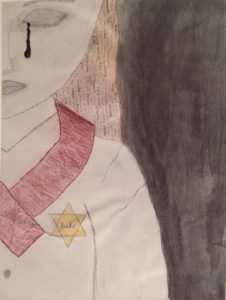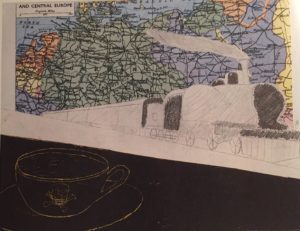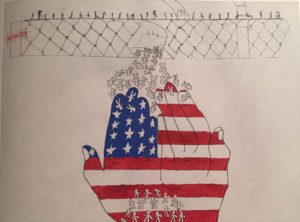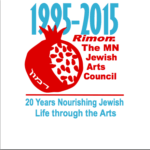The Holocaust is something that’s unquestionably difficult to present to children and have them understand the scope of exactly what happened. Local artist and author Rowan Pope has found a creative and moving way to do just that in the book “Six Chairs: A Holocaust Survivor’s Story,” using the stories of Joe Grosnacht, a Holocaust survivor, alongside artwork of students nearly the same age as Joe at the time he was initially sent to the work camps.
Pope will be speaking at the Sabes JCC on May 5 from 7-9 p.m. The event is free to attend and no registration is required. Pope was able to turn the art and stories into the book thanks to a grant from Rimon: The Minnesota Jewish Arts Council.
 Pope met Grosnacht through his work with Voice to Vision, an anti-genocide art project, while he was a grad student at the University of Minnesota. “Working with David Feinberg on Voice to Vision changed me a great deal,” Pope said. “It opened me up to the profound, true stories of other people from a huge range of cultures, many of whose stories were previously untold to anyone.”
Pope met Grosnacht through his work with Voice to Vision, an anti-genocide art project, while he was a grad student at the University of Minnesota. “Working with David Feinberg on Voice to Vision changed me a great deal,” Pope said. “It opened me up to the profound, true stories of other people from a huge range of cultures, many of whose stories were previously untold to anyone.”
Joe was the first to be interviewed for the project and Pope looked to honor Joe’s experiences and heroic actions during the war. “In the interviews I did with Joe, what most affected me most were the stories he told, what he overcame to survive, the lengths he had to go to to survive. It opened my eyes about what human beings are capable of – not only in terms of cruelty but also in terms of the will to live,” Pope told me. “Something that also struck me in my interviews was Joe’s amazing, optimistic, hopeful attitude. He survived one of history’s great tragedies and came out of it an incredibly warm, friendly, and positive person.”
The book has 17 stories of one page or less to take readers through Joe’s life – from childhood through work camps, Auschwitz, liberation by U.S. soldiers, and on to his journey to the United States.
 “The book was always meant to be something teens would read and be inspired by – especially teens, since they are at an age at which they are open to important concepts about the Holocaust,” Pope said “It’s a perfect age for them to explore that material. But I also believe adults can get something out of the book. I deliberately wrote the stories in such a way that people of almost any age could understand them and get something from them.”
“The book was always meant to be something teens would read and be inspired by – especially teens, since they are at an age at which they are open to important concepts about the Holocaust,” Pope said “It’s a perfect age for them to explore that material. But I also believe adults can get something out of the book. I deliberately wrote the stories in such a way that people of almost any age could understand them and get something from them.”
The story of Grosnacht’s life as the only member of his family to survive the Holocaust is certainly powerful enough, but the choice that Pope made in allowing students from Breck School to provide the artwork added an extra level to the book. I asked him about being an artist, but not making the majority of the art in the book. “It really wasn’t difficult for me to give the reigns to the students, and in fact it made the process even more exciting and fascinating, however unpredictable the results,” he told me. “I wanted to give the students the freedom to explore the story they were working from, to experiment, to be themselves, and to produce something of meaning to them personally. The process wasn’t about me, or about what I had to say, it was about the students, what they could learn, and what they had to say.”
The only art the author adds to the book is a beautiful portrait of Grosnacht alongside a biography written by Grosnacht’s son at the end of the book. It’s a lovely final image in what is a difficult story, but one that is very important to share. The author does think a bit about the legacy of his work: “I’d like to see it eventually be used in other classrooms and other schools, to educate and inspire young students.”




1 comment